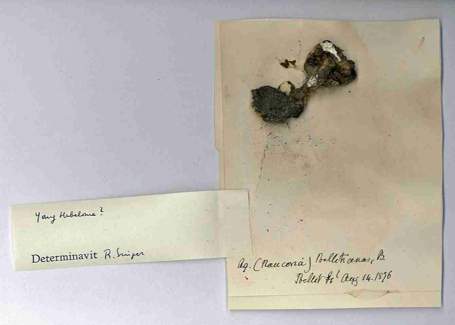 Hebeloma bellotianum (Photo: With thanks to Royal Botanic Gardens, Kew)
Hebeloma bellotianum (Photo: With thanks to Royal Botanic Gardens, Kew)Taxonomy
Full name: Hebeloma bellotianum (Berk.) Beker & U. Eberh., Persoonia 35: 116 (2015)Genus: Hebeloma
Section: Denudata
Subsection: Crustuliniformia
Basionym:
Agaricus bellotianus Berk. [as "Agaricus (Naucoria) bellotianus"], Journal of the Linnean Society 17: 14 (1880)
Types: CANADA: Nunavut: Bellot Island (approx. 81.7002°N, 64.8871°W, alt. approx. 0 m a.s.l.) in arctic tundra, 14 Aug. 1876, C. Feilden, det: M.J. Berkeley (Holotype. herbarium acc. no. K(M)165365, HJB1000245).
- arrow_drop_downarrow_drop_upEtymology
- arrow_drop_downarrow_drop_upOriginal diagnosisPileo convexo carnoso; stipite sursum granulato-pulverulento, deorsum incrassato, e massa claviformi oriundo; lamellis argillaceis; sporis majoribus.
- arrow_drop_downarrow_drop_upEnglish translationPileus convex, fleshy; stipe granulose-pulverulent above, enlarged towards base, originating from a clavate mass; lamellae argillaceous; spores somewhat large.
References
Description
- arrow_drop_downarrow_drop_upThresholds
Description of Hebeloma bellotianum based on 1 collections
- arrow_drop_downarrow_drop_upMacroscopic descriptionPileus: not recorded mm diameter; shape Not recorded; characters Not recorded; margin characters Not recorded; viscosity tacky when moist; colour variation Not recorded; colour at centre Not recorded.
Lamellae: attachment Not recorded; maximum depth not recorded; number of complete lamellae up to 60; presence of tears Not recorded; white fimbriate edge Not recorded.
Cortina presence: no.
Stipe: not recorded x not recorded {median} x not recorded {basal} mm; stipe Q not recorded; base shape clavate; floccosity floccose; rooting Not recorded; thick rhizoids at base Not recorded;
Context: Texture firm; stipe interior Not recorded; stipe flesh discolouring Not recorded; slenderness measure not recorded; smell Not recorded; taste Not recorded.
Spore deposit colour: Not recorded.
Exsiccata characters: Not recorded.
- arrow_drop_downarrow_drop_upMicroscopic descriptionSpores: shape amygdaloid or ovoid; colour in microscope Not recorded; guttules Not recorded. papilla yes; Spore Code: O1; P0; D1 D2.
Basidia: not recorded x not recorded μm; ave. Q not recorded; spore arrangement Not recorded;
Cheilocystidia: main shape capitate-stipitate or clavate-stipitate; special features observed often many collapsed in exsiccata; cheilocystidia ratios: A/M = up to 2.62; A/B = up to 2.57; B/M = up to 1.09.
Pleurocystidia: none seen.
Ixocutis: epicutis thickness (measured from exsiccata) up to 100 μm; ixocutis hyphae width up to 5 μm; ixocutis hyphae encrustation Not recorded; shape of trama elements beneath subcutis ellipsoid or thickly sausage-shaped.
Caulocystidia: Similar to cheilocystidia but larger.
- arrow_drop_downarrow_drop_upSpore measurements
- arrow_drop_downarrow_drop_upCheilocystidia measurements
- arrow_drop_downarrow_drop_upHabitat and distributionNo associated genera are recorded for the species. No growth habit has been recorded.
According to our current collections, the species is found only in Northern America. From collector information, it appears collections have been found in the IUCN habitats We map from the collector's description of the habitat to the International Union for Conservation of Nature (IUCN)'s definition using a standardised set of rules. Please see this page for a full list of IUCN habitats.. Within Northern America all our records are from Subarctic America (Nunavut).
- arrow_drop_downarrow_drop_upCommentaryAs discussed in Eberhardt et al. (2015a), we have examined material of Hebeloma bellotianum, which was recorded in 1876 from Bellot Island in Canada by Capt. Feilden and described by M.J. Berkeley as Agaricus (Naucoria) bellotianus in 1878. Hebeloma bellotianum has cheilocystidia that clearly place it in H. subsect. Crustuliniformia and, given the habitat at more then 81 deg N, it falls into the arctic/alpine group from this subsection. The number of lamellae (estimated from the exsiccata) and spore size would mean that it would key out, among known species from this subsection, as H. alpinum, to which it is certainly closely related and were it not for the very large spores we would be confident this was the same species. However, the spores of H. bellotianum measured, on average, 14.7 × 7.1 μm, while the largest average spore size we have measured for H. alpinum (across 72 collections) is 13.7 μm long (and 7.7 μm wide). We have not been able to obtain any molecular data from this collection and cannot rule out that this may be a species from H. subsect. Crustuliniformia that we have not yet encountered. Thus, at this point, we hesitate to synonymize these species and await further evidence one way or the other.
Geographic distribution
Phenology
- arrow_drop_downarrow_drop_upAdditional cited collections